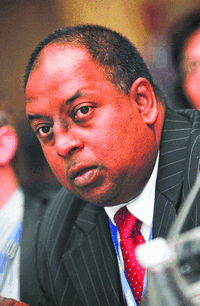SriLankan says it is "business as usual" despite the termination of a 10-year management agreement with Emirates
New SriLankan Airlines chief executive Manoj Gunawardena says there have been few changes since Emirates terminated its management contract with the flag carrier at the end of March.
Emirates had been managing SriLankan for 10 years but in reality it only had a small number of managers seconded to the carrier, led by chief executive Peter Hill, who has now returned to Dubai where he is helping establish the city's planned low-cost carrier. Gunawardena was a 25-year veteran of the Sri Lankan national carrier and many saw his promotion from head of worldwide sales to chief executive as a natural progression.
The departure of Emirates from SriLankan was acrimonious and it came after long-running talks on an extension of the management agreement ended in a public spat. This was in part due to the fact that Hill had his work permit revoked after a dispute with Sri Lanka's president. Bizarrely, he spent his final few months of managing SriLankan remotely from Dubai.
Emirates has since said it is looking to sell its more than 40% stake in the airline, which it bought into in 1998, although it insists it is in no hurry. Emirates president Tim Clark says the Dubai-based carrier learned much from its experience at SriLankan. He says it looked like a very attractive investment when the original buy-in deal was done in 1998, but "on balance I would say it was probably marginal in its return".
Emirates still has three board seats, with the government having four, and Gunawardena says there has been little trouble since the end of the management agreement. "The direction that is coming from the board - both from the government and Emirates - is business as usual," he said in an interview with Airline Business at the IATA annual general meeting in early June.
"The government has made clear that this ought to be run as a commercial enterprise. There will not be any political interference. There is nothing whatsoever to indicate that the government has any agenda or any interest other than the commercial success of SriLankan Airlines."
Gunawardena says the abrupt severing of a longstanding codeshare agreement between the two carriers did have an impact on some route revenue, such as on services between Colombo and Dubai, the Maldives and Singapore. But he says the impact was not significant overall.
 |
|---|
"The government has made it clear that this ought to be run as a commercial enterprise"Manoj Gunawardena |
The two carriers also no longer have a common frequent-flyer programme but Gunawardena says there is a possibility SriLankan's new programme may be linked to Emirates'. "We might maintain some sort of [frequent flyer] partnership agreement," he says. "We are discussing that."
Gunawardena says he is currently focusing most on cutting costs as fuel prices have continued to increase in recent months, after which longer-term planning can begin. Passenger demand is holding up well, he says, after SriLankan suffered in previous years from the return of violence to the country, where separatists have been fighting for a separate homeland. "My immediate priority is getting non-fuel costs down."
He also says SriLankan has no plans to cut or add routes in the near-term but in the coming months will shift capacity around in some markets, for example by putting narrowbody aircraft on thinner routes that are currently served with widebodies.
Fleet Renewal
Gunawardena also says SriLankan has just started to look at replacement options for its five Airbus A320s, two of which it owns and three of which are leased. "That replacement needs to be looked at in the short term. We have just started. We will look at either purchasing or leasing."
He says the carrier is also looking to revamp the cabin interiors of its Airbus A330 and A340 widebody aircraft.
SriLankan is the country's main airline and it has a full-service focus with a similar product to Emirates. Another state-owned carrier, Mihin Lanka, focuses on the low-cost market. Mihin Lanka started operating in April 2007 and its establishment in part complicated the talks between Emirates and the government on an extension of the management agreement, as the government's long-term commitment to SriLankan was in question.
At the time several privately owned carriers were also planned for Sri Lanka, including a Sri Lankan affiliate of Indian low-cost carrier Air Deccan, but none secured final approvals to launch. Mihin Lanka itself stopped operating in late April after both of its aircraft, which were wet-leased, were returned. But it hopes to resume flights in July using a new fleet of dry-leased A320s.
Gunawardena says that contrary to speculation there are no plans to merge SriLankan and Mihin Lanka. He says they did have interline arrangements but "going forward I don't see anything more than that in the short term". He says this is in part due to the fact that SriLankan is 51%-owned by the government while Mihin Lanka is wholly-owned by the state.
Gunawardena's brother, Sajin Vaas Gunawardena, headed Mihin Lanka until the carrier stopped operating and he stepped aside, which paved the way for Gunawardena's appointment as chief executive at SriLankan. Anura Bandara, a former SriLankan executive, has been appointed the new chief executive of Mihin Lanka but Sajin Vaas Gunawardena has remained a member of the board.
Mihin Lanka had been serving from its Colombo base Bangkok, Dubai, Singapore, Male in the Maldives and Bodh Gaya, Trichi and Trivandrum in India. It plans to resume services on the same routes when it restarts operations. Sri Lankan, which in recent years has focused on expanding its network in India where it now has 11 destinations, serves all of Mihin Lanka's destinations except Bodh Gaya.
For more on the departure of Emirates from SriLankan Airlines, go to: flightglobal.com/srilankan
Source: Airline Business
















